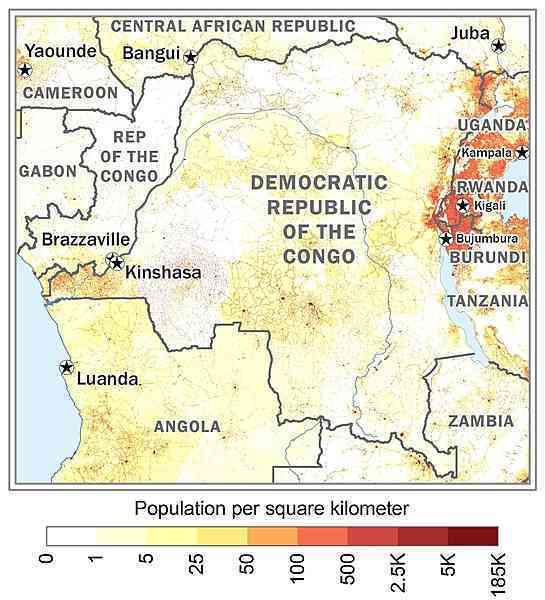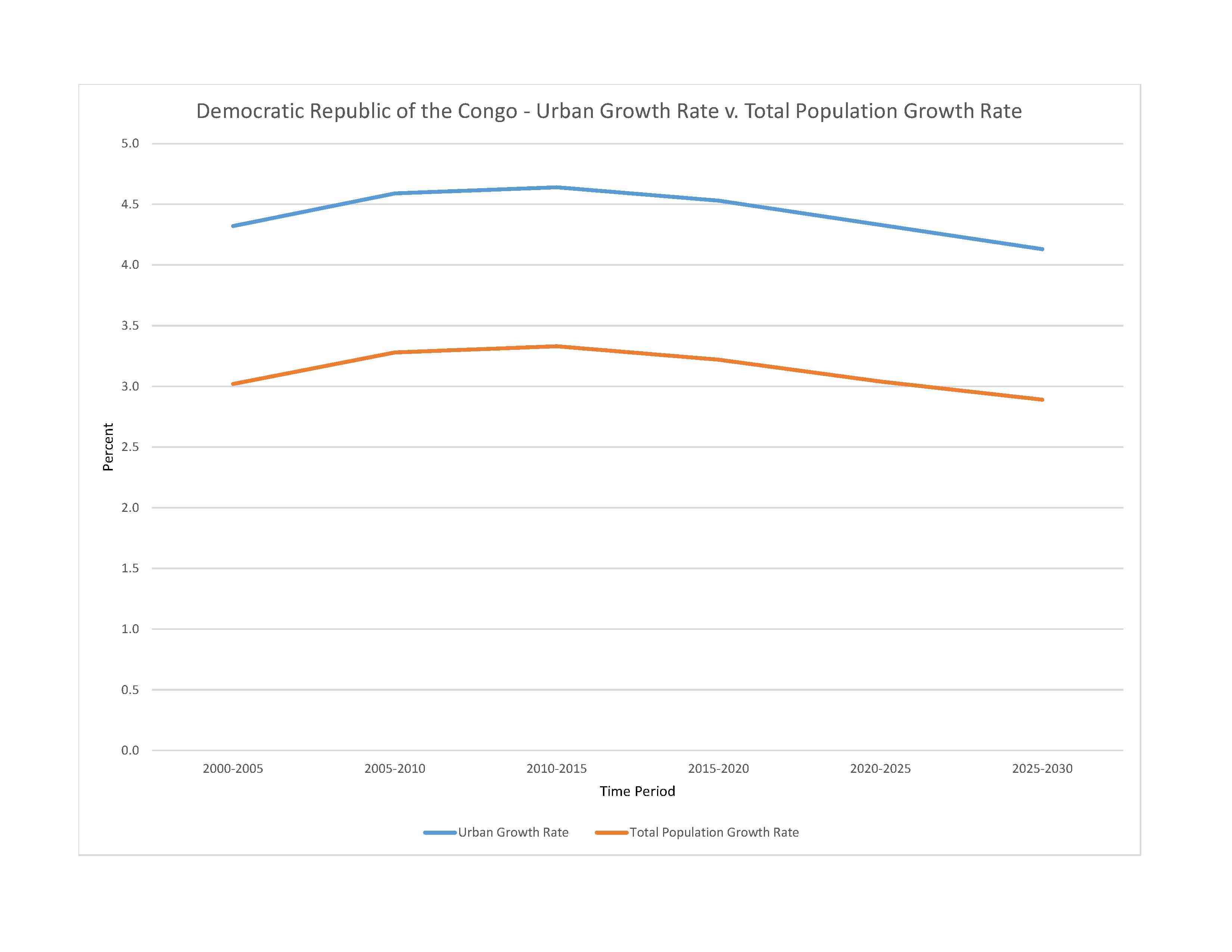
111,859,928 (2023 est.)
noun: Congolese (singular and plural)
adjective: Congolese or Congo
more than 200 African ethnic groups of which the majority are Bantu; the four largest groups - Mongo, Luba, Kongo (all Bantu), and the Mangbetu-Azande (Hamitic) - make up about 45% of the population
French (official), Lingala (a lingua franca trade language), Kingwana (a dialect of Kiswahili or Swahili), Kikongo, Tshiluba
major-language sample(s):
Buku oyo ya bosembo ya Mokili Mobimba Ezali na Makanisi ya Liboso Mpenza. (Lingala)
The World Factbook, the indispensable source for basic information.
Lingala audio sample:
Christian 93/1% (Roman Catholic 29.9%, Protestant 26.7%, other Christian 36.5%), Kimbanguist 2.8%, Muslim 1.3%, other (includes syncretic sects and indigenous beliefs) 1.2%, none 1.3%, unspecified 0.2% (2014 est.)
Despite a wealth of fertile soil, hydroelectric power potential, and mineral resources, the Democratic Republic of the Congo (DRC) struggles with many socioeconomic problems, including high infant and maternal mortality rates, malnutrition, poor vaccination coverage, lack of access to improved water sources and sanitation, and frequent and early fertility. Ongoing conflict, mismanagement of resources, and a lack of investment have resulted in food insecurity; almost 25% of children under the age of 5 were malnourished as of 2018. The overall coverage of basic public services – education, health, sanitation, and potable water – is very limited and piecemeal, with substantial regional and rural/urban disparities. Fertility remains high at more than 5 children per woman and is likely to remain high because of the low use of contraception and the cultural preference for larger families.
The DRC is a source and host country for refugees. Between 2012 and 2014, more than 119,000 Congolese refugees returned from the Republic of Congo to the relative stability of northwest DRC, but more than 1 million Congolese refugees and asylum seekers were hosted by neighboring countries as of December 2022. In addition, an estimated 5.5 million Congolese were internally displaced as of October 2022, the vast majority fleeing violence between rebel group and Congolese armed forces. Thousands of refugees have come to the DRC from neighboring countries, including Rwanda, the Central African Republic, South Sudan, and Burundi.
0-14 years: 45.99% (male 25,902,046/female 25,543,395)
15-64 years: 51.52% (male 28,798,920/female 28,835,212)
65 years and over: 2.49% (2023 est.) (male 1,211,966/female 1,568,389)
total dependency ratio: 98
youth dependency ratio: 92.1
elderly dependency ratio: 5.9
potential support ratio: 17.1 (2021 est.)
total: 16.8 years (2023 est.)
male: 16.6 years
female: 16.9 years
3.13% (2023 est.)
39.6 births/1,000 population (2023 est.)
7.7 deaths/1,000 population (2023 est.)
-0.6 migrant(s)/1,000 population (2023 est.)
urban clusters are spread throughout the country, particularly in the northeast along the border with Uganda, Rwanda, and Burundi; the largest city is the capital, Kinshasha, located in the west along the Congo River; the south is least densely populated as shown in this 
urban population: 47.4% of total population (2023)
rate of urbanization: 4.33% annual rate of change (2020-25 est.)

16.316 million KINSHASA (capital), 2.892 million Mbuji-Mayi, 2.812 million Lubumbashi, 1.664 million Kananga, 1.423 million Kisangani, 1.249 million Bukavu (2023)
at birth: 1.03 male(s)/female
0-14 years: 1.01 male(s)/female
15-64 years: 1 male(s)/female
65 years and over: 0.77 male(s)/female
total population: 1 male(s)/female (2023 est.)
19.9 years (2013/14 est.)
note: data represents median age at first birth among women 20-49
547 deaths/100,000 live births (2020 est.)
total: 59.1 deaths/1,000 live births (2023 est.)
male: 64.7 deaths/1,000 live births
female: 53.4 deaths/1,000 live births
total population: 62.2 years (2023 est.)
male: 60.4 years
female: 64.1 years
5.56 children born/woman (2023 est.)
2.74 (2023 est.)
28.1% (2017/18)
improved: urban: 88.8% of population
rural: 34.7% of population
total: 59.4% of population
unimproved: urban: 11.2% of population
rural: 65.3% of population
total: 40.6% of population (2020 est.)
4.1% of GDP (2020)
0.38 physicians/1,000 population (2018)
improved: urban: 53.4% of population
rural: 20.5% of population
total: 35.5% of population
unimproved: urban: 46.6% of population
rural: 79.5% of population
total: 64.5% of population (2020 est.)
degree of risk: very high (2023)
food or waterborne diseases: bacterial and protozoal diarrhea, hepatitis A, and typhoid fever
vectorborne diseases: malaria, dengue fever, and trypanosomiasis-gambiense (African sleeping sickness)
water contact diseases: schistosomiasis
animal contact diseases: rabies
note: on 31 August 2023, the US Centers for Disease Control and Prevention (CDC) issued a Travel Alert for polio in Africa; the Democratic Republic of the Congo is currently considered a high risk to travelers for circulating vaccine-derived polioviruses (cVDPV); vaccine-derived poliovirus (VDPV) is a strain of the weakened poliovirus that was initially included in oral polio vaccine (OPV) and that has changed over time and behaves more like the wild or naturally occurring virus; this means it can be spread more easily to people who are unvaccinated against polio and who come in contact with the stool or respiratory secretions, such as from a sneeze, of an “infected” person who received oral polio vaccine; the CDC recommends that before any international travel, anyone unvaccinated, incompletely vaccinated, or with an unknown polio vaccination status should complete the routine polio vaccine series; before travel to any high-risk destination, the CDC recommends that adults who previously completed the full, routine polio vaccine series receive a single, lifetime booster dose of polio vaccine
6.7% (2016)
total: 0.56 liters of pure alcohol (2019 est.)
beer: 0.5 liters of pure alcohol (2019 est.)
wine: 0.01 liters of pure alcohol (2019 est.)
spirits: 0.05 liters of pure alcohol (2019 est.)
other alcohols: 0 liters of pure alcohol (2019 est.)
total: 12.8% (2020 est.)
male: 22.7% (2020 est.)
female: 2.9% (2020 est.)
23.1% (2017/18)
55.3% (2023 est.)
women married by age 15: 8.4%
women married by age 18: 29.1%
men married by age 18: 5.6% (2018 est.)
2.7% of GDP (2021 est.)
definition: age 15 and over can read and write French, Lingala, Kingwana, or Tshiluba
total population: 80%
male: 89.5%
female: 70.8% (2021)
total: 11 years
male: 10 years
female: 9 years (2013)
NOTE: The information regarding Congo Democratic Republic of The on this page is re-published from the 2024 World Fact Book of the United States Central Intelligence Agency and other sources. No claims are made regarding the accuracy of Congo Democratic Republic of The 2024 information contained here. All suggestions for corrections of any errors about Congo Democratic Republic of The 2024 should be addressed to the CIA or the source cited on each page.
This page was last modified 04 May 24, Copyright © 2024 ITA all rights reserved.